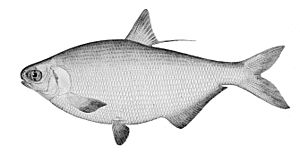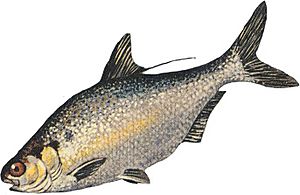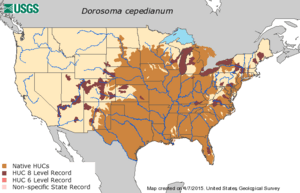American gizzard shad facts for kids
Quick facts for kids American gizzard shad |
|
|---|---|
 |
|
| Conservation status | |
| Scientific classification |
The American gizzard shad (Dorosoma cepedianum), also called the mud shad, is a type of herring fish. It lives in many fresh and salty waters across the United States. Adult gizzard shad have a deep body. They are silvery-green on top and plain silver underneath.
These fish usually live in freshwater lakes, reservoirs, rivers, and streams. They can also be found in brackish (slightly salty) waters, like along the Atlantic coast. Their home range covers most of the United States. They typically don't go farther north than New York or west than New Mexico. Gizzard shad are a big part of their ecosystems. They can change the amounts of phyto- and zooplankton in the water. This indirectly affects other fish that eat plankton. People have often used gizzard shad as food for game fish.
Contents
What Does the Gizzard Shad Look Like?
The gizzard shad has a special back fin (dorsal fin). It starts behind their belly fins. The last ray of this fin is very long in adult fish, but not in young ones. They also have a long anal fin with 25 to 36 soft rays.
Their mouth is on the lower part of their head. The upper jaw is short and wide. The lower jaw is smaller and weaker. Adult gizzard shad do not have teeth. They also have many gill rakers, which help them filter food from the water. Their belly fins are located near their chest.
Gizzard shad can be very small when they are young. The biggest one ever found was about 47.7 cm long and weighed 1.56 kg. Fish in northern waters are usually bigger. For example, a three-year-old might be 28.4 cm long. A ten-year-old could be 39.9 cm long. They have a very small lateral line system. This system helps fish sense movement. To make up for this, they have other ways to feel things moving around them.
Where Do Gizzard Shad Live?
Historically, gizzard shad have lived from North Dakota to New Mexico. They are also found from Florida up to New York Harbor. They were not seen in many of the Great Lakes until the late 1800s and early 1900s. However, scientists think they might have always lived in Lake Erie. They likely reached it after the last ice age.
Gizzard shad usually live in lakes and reservoirs. But they can also live in rivers, streams, and brackish waters. They prefer the open water areas of lakes. In some lakes, they can make up to 80% of all the fish by weight. They like shallow lakes with muddy bottoms. They also prefer water that is not very clear. This might be because of where they lay their eggs. It also helps them survive better. They have a harder time living in clear water or water with lots of plants.
What Do Gizzard Shad Eat?
When gizzard shad are young, they eat plankton. This includes tiny plants (phytoplankton) and tiny animals (zooplankton). Young fish can eat so much zooplankton that it causes the zooplankton population to drop. This can affect the whole ecosystem.
In many reservoirs in the Midwest USA, gizzard shad are very common. There, they often switch to eating mostly dead plant and animal matter (detritus) as they get older. In some natural lakes, they might keep eating zooplankton their whole lives. Zooplankton is better for them than detritus. So, if large zooplankton like Daphnia are available, gizzard shad probably prefer to eat them. But in many reservoirs, large zooplankton are rare. So, gizzard shad rely on detritus.
Their growth might be slower when they only eat detritus. They may eat more zooplankton when there are fewer gizzard shad around. They also eat more zooplankton when there are lots of large-bodied zooplankton. In these cases, Daphnia and other crustaceans become a big part of their diet. Gizzard shad mostly eat during the day. They are not very active at night. In Lake Mead, Arizona, they have been seen gathering in schools in shallow water at night during the fall.
How Do Gizzard Shad Reproduce?
Gizzard shad usually start laying eggs between mid-May and early June. This happens when the water temperature rises. The number of eggs a fish lays changes between different groups. A two-year-old might lay 12,500 eggs. A four-year-old can lay up to 380,000 eggs.
They lay their eggs in shallow water in clumps. It seems they don't pair up with a single partner. They spawn in the evening and early night hours. The eggs stick to underwater plants. The parents do not take care of the eggs. Young fish start eating three to four days after hatching. Most are about 3.3 mm long when they hatch.
Gizzard shad lay many eggs and grow quickly. This means they can become a very large part of an ecosystem very fast. They can also create hybrid fish by breeding with the threadfin shad, which is a close relative.
Why Are Gizzard Shad Important for Fisheries?
Gizzard shad were put into many lakes and rivers. This was done to provide food for game fish like walleye, bass, and trout. They are small and found in large numbers. People thought they would be easy food for game fish. This would help increase game fish numbers. It would also reduce pressure on other prey fish, like the bluegill.
However, gizzard shad grow very fast. They can quickly become too big for many predators to eat. Also, they lay many eggs. So, many of them survive past their first year. This makes them almost impossible for predators to catch. They also compete with other fish species for food. This can cause the populations of other fish to decline.
Even so, gizzard shad can help an ecosystem. They bring nutrients up from the bottom where detritus settles. This makes these nutrients available to other predator species.
What Does "Gizzard Shad" Mean?
The gizzard shad gets its name because it has a gizzard. This is a special sack filled with rocks or sand. It helps the fish break down the food it eats.
Its genus name, Dorosoma, describes its body shape when young. Doro means lance-shaped, and soma means body. The species name, cepedianum, honors a French fish scientist named La Cépède.
Gizzard Shad and Water Safety
Gizzard shad are important for testing chemicals in water. Because they are a key part of the food web and lay many eggs, they are like the "canary in the coal mine" for water safety. This means they can show if there are problems in the water. Even though some people see gizzard shad as "unwanted," their role in the environment is actually quite important.
Images for kids





